Research
November 30, 2017
Massive Hurricanes Could Change State and Local Populations
Summary
- In the aftermath of massive hurricanes, individuals and families are often faced with a difficult choice – to stay and begin the long rebuilding process, or to leave devastation behind and restart elsewhere.
- In the wake of the recent hurricanes, states should be prepared for the potential influx of individuals moving from areas impacted by these hurricanes.
- An examination of population trends in regions overwhelmingly impacted by the three costliest hurricanes in American history suggest that hurricanes disrupt population trends, and in some cases, can cause out-migration.
Introduction
Over the last few months, the United States and its territories have been hit by three major hurricanes, causing billions of dollars in damage. As Texas, Florida, and Puerto Rico begin to rebuild, some residents may find the damage too overwhelming to overcome and consider relocating elsewhere. While several states anticipated a mass influx of migrants from Puerto Rico, should states also be concerned about individuals leaving parts of Texas and Florida? To answer this question the American Action Forum (AAF) looked at state, county, and city Census population estimates in areas previously devastated by hurricanes in the United States to identify any patterns of out-migration following a disaster. This research specifically analyzes population trends in areas impacted by the three costliest hurricanes in United States history, according to the National Oceanic and Atmospheric Administration.[1] AAF finds disruptions in population trends in areas affected by Hurricane Katrina, Hurricane Ike, and Hurricane Sandy, with some areas experiencing rapid declines in populations, indicating these disasters may have lead some individuals to leave permanently.
Hurricane Ike (2008)
Hurricane Ike was a Category 2 hurricane upon making landfall over Galveston Island, TX on September 13, 2008. Ike caused extensive damage with sustained winds of 110 mph – just 1 mph short of a Category 3 hurricane – and wide-spread coastal flooding. The damage to homes, businesses, and infrastructure devastated communities along the Texas Gulf Coast. Hurricane Ike currently ranks as the third costliest hurricane in United States history with damages totaling an estimated $30 billion.
The majority of Ike’s devastation impacted Galveston County – specifically Galveston Island. The Houston-Galveston Area Council of Governments found that Ike left more than 53,000 employees unemployed, and damaged more than 18,000 businesses in Galveston County.[2] Unsurprisingly, Galveston County experienced a population decrease of roughly 1,200 people in 2009. This rapid decrease in population deviates from the consistent population increase seen in previous years. The slight decrease in Galveston County’s population may be due in part to the large outmigration in the City of Galveston. Galveston Island – part of the City of Galveston– took a direct hit from Ike and endured more than 12 hours of inundation from Ike’s 15-foot storm surge. As a result, nearly 50 percent of Galveston Island was flooded. Although the city of Galveston’s population had been steadily decreasing since 2004, in 2009 its population declined at a greater rate than previous years. The impact of Ike likely sparked additional outmigration from Galveston, where many residents had already been leaving the city due to its rising housing costs. The graphs below show the impact of Hurricane Ike on both Galveston County and Galveston City populations, and the dashed line indicates the year during which Hurricane Ike occurred.
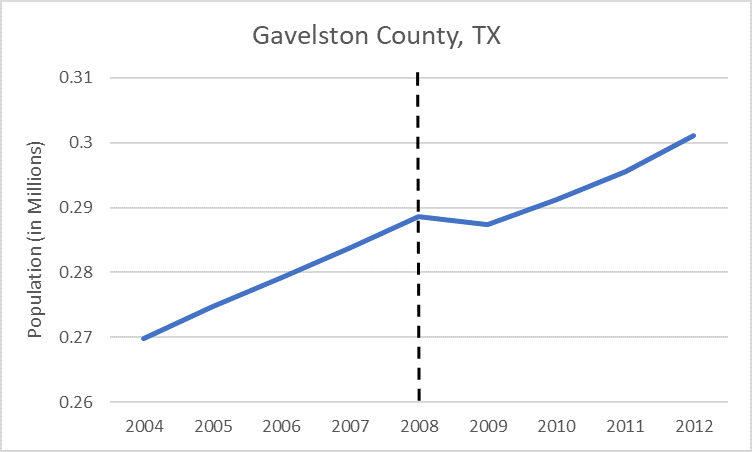
 Damage from Ike was also widespread in Orange County, largely devastating the county’s Bridge City, and the City of Orange. After Hurricane Ike, Orange County’s population decreased by about 1,000 people. This decrease came after two years of significant population growth. However, Orange County endured multiple hurricanes from 2005 to 2008, making its population relatively unstable. For example, the drop in Orange County’s population from 2005 to 2006, seen in the graph below, is likely associated with Hurricane Rita, which hit the county in 2005.
Damage from Ike was also widespread in Orange County, largely devastating the county’s Bridge City, and the City of Orange. After Hurricane Ike, Orange County’s population decreased by about 1,000 people. This decrease came after two years of significant population growth. However, Orange County endured multiple hurricanes from 2005 to 2008, making its population relatively unstable. For example, the drop in Orange County’s population from 2005 to 2006, seen in the graph below, is likely associated with Hurricane Rita, which hit the county in 2005.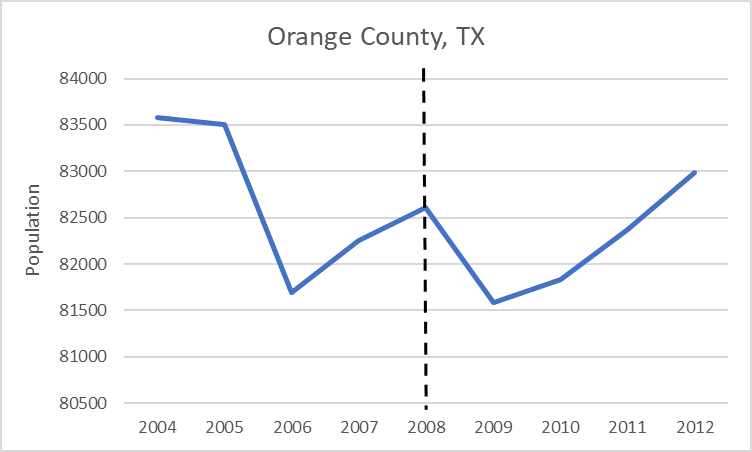 Among the cities in Orange County, Bridge City and the City of Orange suffered the greatest damage from Ike. In Bridge City, only 14 of its 3,400 homes remained inhabitable after Ike. Furthermore, all businesses reported some level of damage due to the storm, and the two elementary schools in the city were unsalvageable. Unsurprisingly, Bridge City’s population decreased by 150 people after Ike. The City of Orange saw a much larger decline in its population, decreasing by roughly 1,000. After Ike hit, the Mayor of Orange estimated that a third of the city was flooded anywhere from six inches to six feet. These two cities were left with damage that took months to recover from, resulting in population declines as seen in the two graphs below.
Among the cities in Orange County, Bridge City and the City of Orange suffered the greatest damage from Ike. In Bridge City, only 14 of its 3,400 homes remained inhabitable after Ike. Furthermore, all businesses reported some level of damage due to the storm, and the two elementary schools in the city were unsalvageable. Unsurprisingly, Bridge City’s population decreased by 150 people after Ike. The City of Orange saw a much larger decline in its population, decreasing by roughly 1,000. After Ike hit, the Mayor of Orange estimated that a third of the city was flooded anywhere from six inches to six feet. These two cities were left with damage that took months to recover from, resulting in population declines as seen in the two graphs below.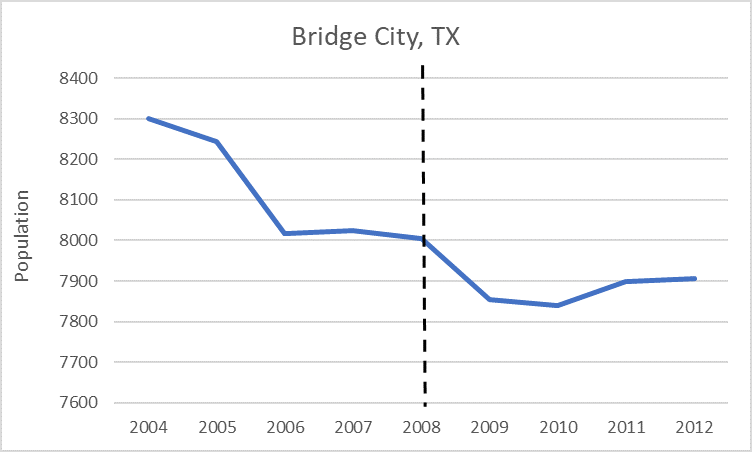
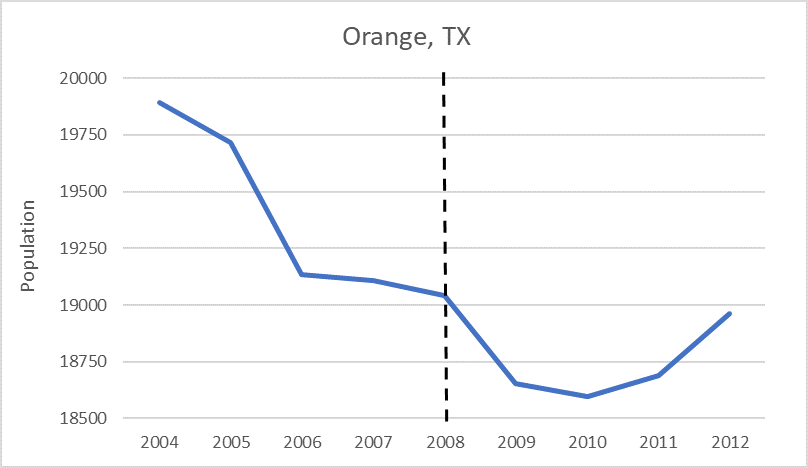
Hurricane Sandy (2012)
Hurricane Sandy was a Category 3 storm that hit the Northeastern United States in November 2012. Sandy was estimated to have caused $65 billion in damage. It currently stands as the second costliest hurricane in the United States history, surpassed only by Hurricane Katrina. Among the 24 states affected by Sandy, New Jersey and New York were the most severely impacted.
Within New Jersey, Ocean and Monmouth counties suffered the greatest damage. The two graphs below show the population in both counties from 2008 to 2016. The dashed line in each graph indicates the year in which Hurricane Sandy occurred. While there is no drastic decline in Ocean County’s population, the rate at which population had been growing in the county decelerated from 2011 to 2013. This disruption in population growth could be attributed to many factors, however, it is worth noting that Sandy did damage or destroy over 40,000 buildings in Ocean County. Unlike Ocean County, Monmouth County has faced a continuous decline in its population since Katrina. Although the decline began after 2010, the county’s population declined at a quicker rate between 2011 to 2012 compared to previous years. This suggests that out-migration in 2012 may have occurred in Monmouth County due to the damage caused by Sandy. 
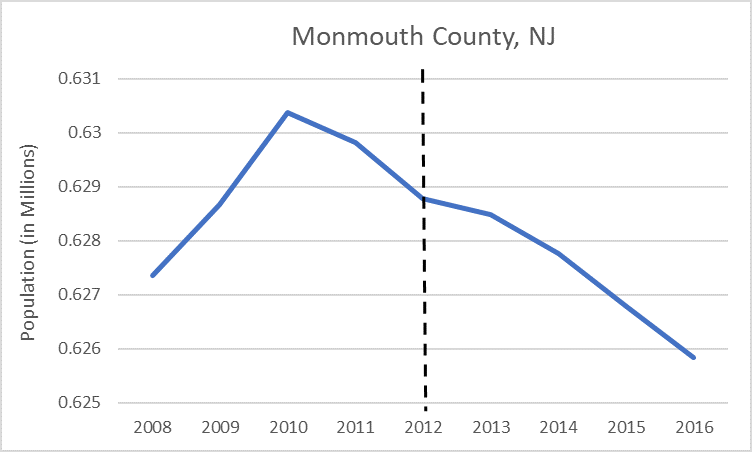 Although Ocean County as a whole saw no significant drop in its population, boroughs within Ocean County that experienced unproportionate damage saw rapid population declines. Hurricane Sandy damaged about 90 percent of properties in Mantoloking, located along the Jersey Shore. While the damage in Mantoloking was severe, many residents had the resources to rebuild. The Census Bureau’s 2006-2010 American Community Survey showed that median household income – in 2010 inflation-adjusted dollars – was $151,667, and zero percent of the population was below the poverty line. Regardless of resources, Mantoloking’s population dropped by 30 individuals, or 10 percent, likely due to the Shore’s vulnerability to storm surge and flood damage, which Sandy highlighted.
Although Ocean County as a whole saw no significant drop in its population, boroughs within Ocean County that experienced unproportionate damage saw rapid population declines. Hurricane Sandy damaged about 90 percent of properties in Mantoloking, located along the Jersey Shore. While the damage in Mantoloking was severe, many residents had the resources to rebuild. The Census Bureau’s 2006-2010 American Community Survey showed that median household income – in 2010 inflation-adjusted dollars – was $151,667, and zero percent of the population was below the poverty line. Regardless of resources, Mantoloking’s population dropped by 30 individuals, or 10 percent, likely due to the Shore’s vulnerability to storm surge and flood damage, which Sandy highlighted.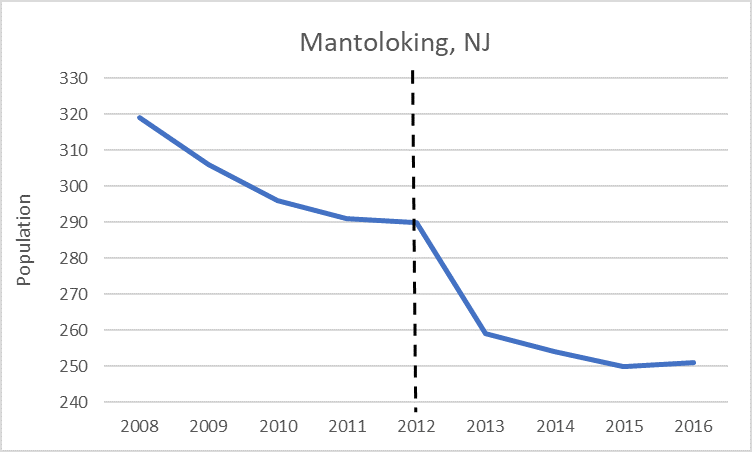 Other boroughs along the Jersey Shore severely hit by Sandy include Seaside Heights – home to Casino Pier and Funtown Pier amusement parks – and Long Beach Township – which contains part of Long Beach Island (LBI). The amusement parks were devastated by Sandy and did not reopen until May 2013, while businesses on LBI were closed for several weeks. The infrastructure and road damage in these two boroughs likely led to the out-migration of individuals and families immediately after Sandy hit, indicated by the decrease in populations from 2011 to 2012 seen in the graphs below.
Other boroughs along the Jersey Shore severely hit by Sandy include Seaside Heights – home to Casino Pier and Funtown Pier amusement parks – and Long Beach Township – which contains part of Long Beach Island (LBI). The amusement parks were devastated by Sandy and did not reopen until May 2013, while businesses on LBI were closed for several weeks. The infrastructure and road damage in these two boroughs likely led to the out-migration of individuals and families immediately after Sandy hit, indicated by the decrease in populations from 2011 to 2012 seen in the graphs below. 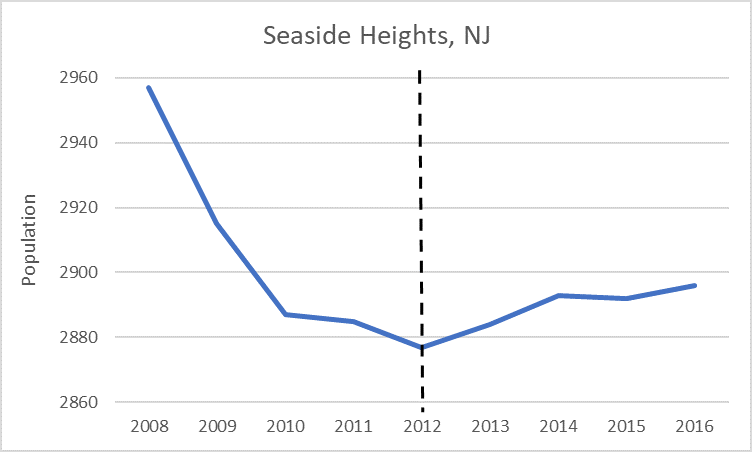
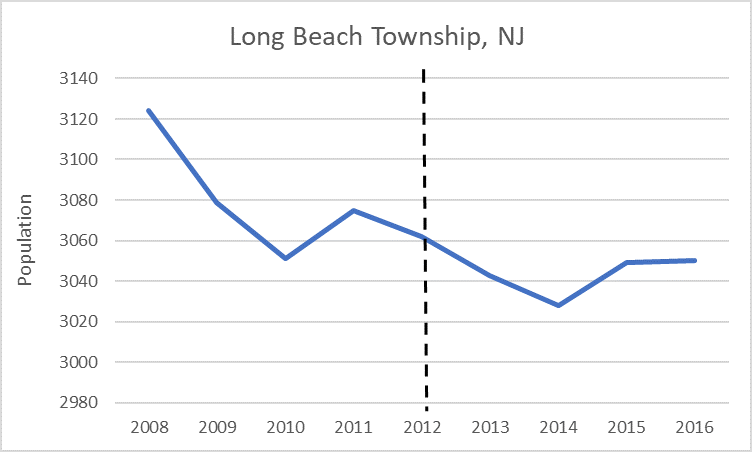 Unlike New Jersey, most populations throughout New York impacted by Sandy remained relatively undisrupted. The most affected areas in the state were in New York City (NYC), and Long Island, which comprises Kings County, Queens County, Suffolk County, and Nassau County. NYC saw an increase in its population between 2011 and 2013, although the rise in population appears to have slowed after 2011, compared to the prior year.
Unlike New Jersey, most populations throughout New York impacted by Sandy remained relatively undisrupted. The most affected areas in the state were in New York City (NYC), and Long Island, which comprises Kings County, Queens County, Suffolk County, and Nassau County. NYC saw an increase in its population between 2011 and 2013, although the rise in population appears to have slowed after 2011, compared to the prior year. In Long Island, populations in Kings, Queens, and Nassau counties increased after Sandy. However, similar to NYC, the population growth in these three counties appear to have slowed slightly from 2011 to 2013. Kings and Queens counties correspond to the New York City boroughs of Brooklyn and Queens, respectively, and have population trends that are nearly identical to NYC. Since these populations continued to increase, Sandy caused no noticeable out-migration in these areas, which suggests individuals are less likely to move away from metropolitan areas after natural disasters. Larger cities often have greater resources at their disposal which allow cities to assist those in need, and rebuild earlier and faster. The only county in Long Island that saw a dip in its population was the suburban Suffolk County. The dip in population for Suffolk County in 2012, along with the greater disruption in population growth seen in Nassau County compare to Kings and Queens counties further supports the theory that hurricanes have a great impact on suburban populations than metropolitan populations.
In Long Island, populations in Kings, Queens, and Nassau counties increased after Sandy. However, similar to NYC, the population growth in these three counties appear to have slowed slightly from 2011 to 2013. Kings and Queens counties correspond to the New York City boroughs of Brooklyn and Queens, respectively, and have population trends that are nearly identical to NYC. Since these populations continued to increase, Sandy caused no noticeable out-migration in these areas, which suggests individuals are less likely to move away from metropolitan areas after natural disasters. Larger cities often have greater resources at their disposal which allow cities to assist those in need, and rebuild earlier and faster. The only county in Long Island that saw a dip in its population was the suburban Suffolk County. The dip in population for Suffolk County in 2012, along with the greater disruption in population growth seen in Nassau County compare to Kings and Queens counties further supports the theory that hurricanes have a great impact on suburban populations than metropolitan populations.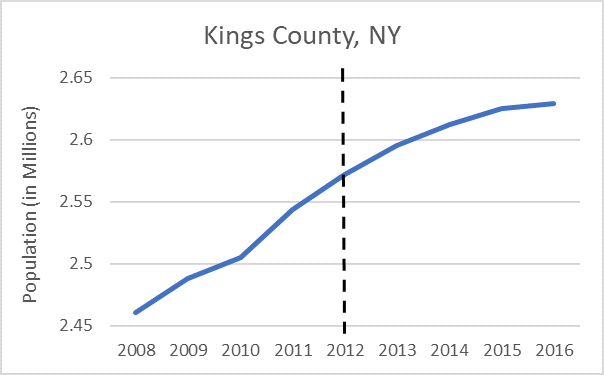

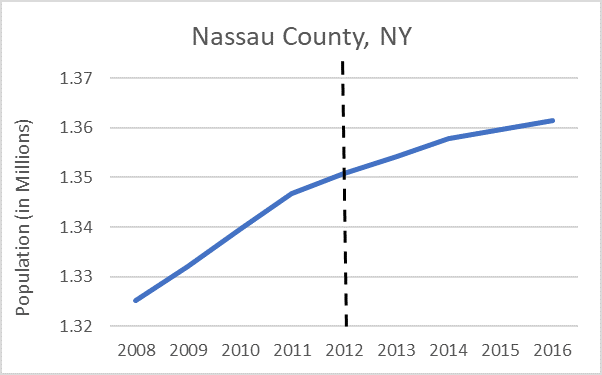
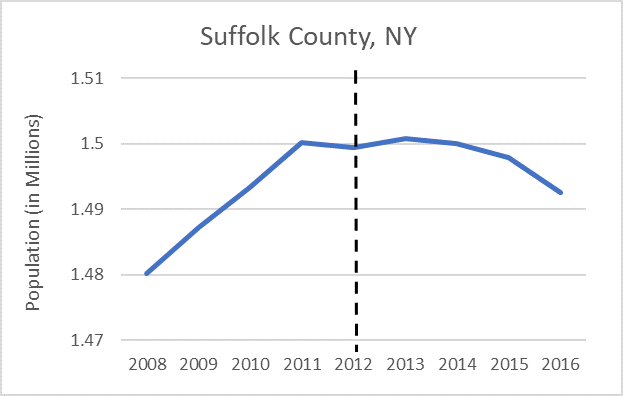
Hurricane Katrina (2005)
Hurricane Katrina is currently the costliest natural disaster in United States history. The storm made landfall in Louisiana as a category 4 hurricane on August 29, 2005. Katrina went on to devastate the Southern United States, causing the most damage to Louisiana and Mississippi. The storm is estimated to have caused $125 billion in damage, with the majority concentrated in New Orleans. Prior to Katrina, New Orleans had nearly 30 percent of its population living in poverty. Katrina’s downpour flooded nearly 80 percent of New Orleans, leaving many of New Orleans’ poorest citizens homeless, with a lack of resources to rebuild.
The graphs below show the impact Katrina had on the population of Louisiana and the city of New Orleans. Both Louisiana and the city of New Orleans saw population decreases of 300,000 people from 2005 to 2006. These nearly identical population decreases indicate the population change in New Orleans was likely the driving factor behind the state’s population decrease. Had other cities in Louisiana experienced a similar population decrease as New Orleans, we would expect Louisiana’s population to decline with greater magnitude. Although there are many variables that impact population, the rapid and sudden decline in population a year after Katrina hit suggests New Orleans’ decrease in population was due to the momentous damage caused by the hurricane.
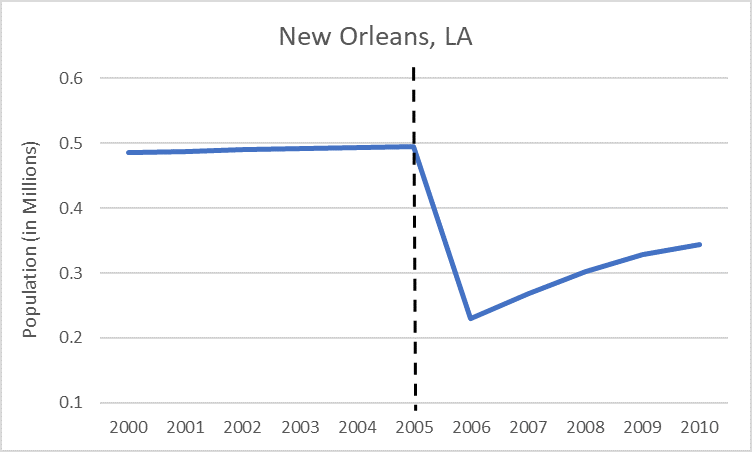 After damaging New Orleans and the surrounding area, Hurricane Katrina devastated the Gulf Coast of Mississippi, which comprises Hancock County, Harrison County, and Jackson County. Looking at the state’s population, it appears Mississippi’s population growth decreases slightly from 2005 to 2006 as seen in the first graph below. While the decrease is minimal, it should be noted this decrease is a deviation in the population growth of the prior five years. From 2000 to 2005 Mississippi’s population consistently grew from year to year. The decrease in population from 2005 to 2006 is the only decrease Mississippi’s population experiences from 2000 to 2010.
After damaging New Orleans and the surrounding area, Hurricane Katrina devastated the Gulf Coast of Mississippi, which comprises Hancock County, Harrison County, and Jackson County. Looking at the state’s population, it appears Mississippi’s population growth decreases slightly from 2005 to 2006 as seen in the first graph below. While the decrease is minimal, it should be noted this decrease is a deviation in the population growth of the prior five years. From 2000 to 2005 Mississippi’s population consistently grew from year to year. The decrease in population from 2005 to 2006 is the only decrease Mississippi’s population experiences from 2000 to 2010.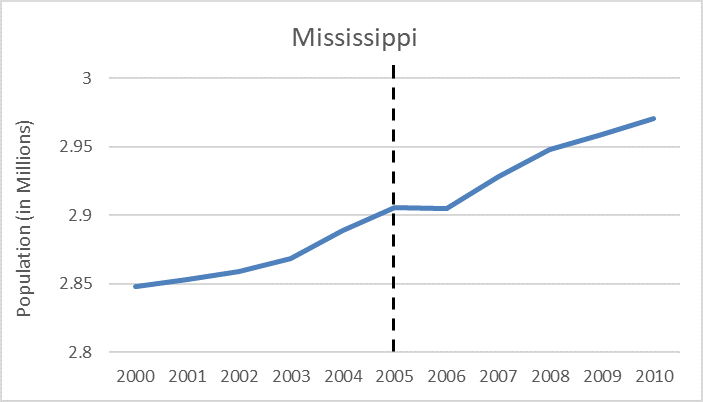

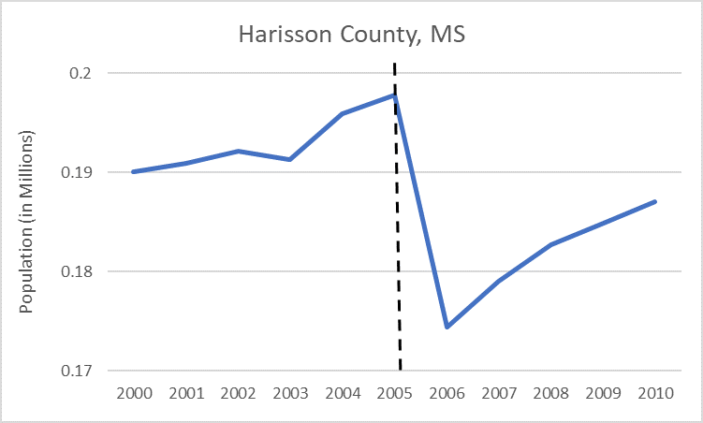
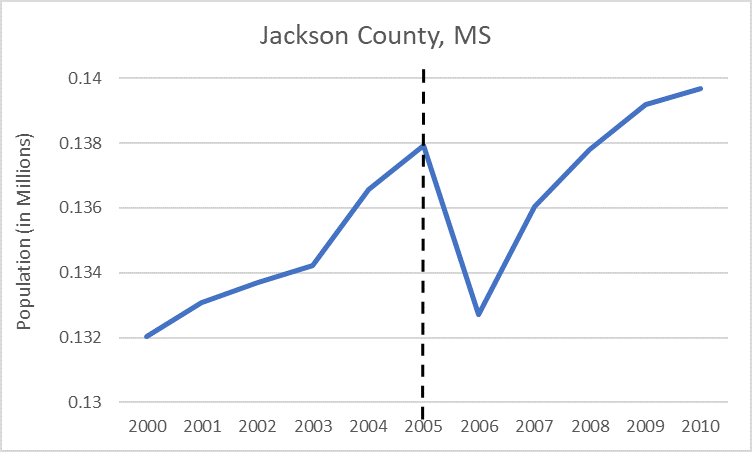 Looking specifically at the three counties that make up the Gulf Coast of Mississippi, it appears there is a larger population response to Katrina in these counties than seen in Mississippi’s population. Hancock County’s population decreased by nearly 8,000 people; Harrison County saw a 23,000 person drop in its population; and Jackson saw a population decrease of about 5,000 people. Since there was a slight decline Mississippi’s population, the decrease in populations among counties in the Gulf Coast of Mississippi, suggest these residents out-migrated from the Gulf to more inland areas within the state, with a very few leaving the state completely.
Looking specifically at the three counties that make up the Gulf Coast of Mississippi, it appears there is a larger population response to Katrina in these counties than seen in Mississippi’s population. Hancock County’s population decreased by nearly 8,000 people; Harrison County saw a 23,000 person drop in its population; and Jackson saw a population decrease of about 5,000 people. Since there was a slight decline Mississippi’s population, the decrease in populations among counties in the Gulf Coast of Mississippi, suggest these residents out-migrated from the Gulf to more inland areas within the state, with a very few leaving the state completely.
Conclusion
While some residents of Texas, Florida, and Puerto Rico have started the rebuilding process in their communities, others may find the task to be too much to handle. Early estimates suggest hurricanes Harvey, Irma, and Maria may surpass the cost of damages from Hurricane Katrina. While many of the impacted areas in Texas and Florida are metropolitan areas, the devastation in these areas is so great that it would not be startling to see slight disruptions in the populations of these affected areas. Hurricane Harvey alone dumped 25.4 trillion gallons of water on the Houston area over the course of six days which is not expected to recede for months, similar to what occurred in New Orleans after Katrina. Puerto Rico also finds itself in a similar situation to New Orleans during Katrina. Prior to hurricanes Irma and Maria, nearly 44 percent of the island was living in poverty. The majority of Puerto Rico’s population does not have the financial resources to begin rebuilding their homes and businesses. The catastrophic event also wiped out the majority of Puerto Rico’s infrastructure, including its electric grid. While some Puerto Ricans may not be financially capable of relocating, citizens with higher education and young adults may now view a move to the mainland as a chance for greater opportunities given Puerto Rico’s ongoing economic crisis. While out-migration from these devastated areas is not guaranteed, history has shown that states and communities should be prepared for an uptick in hurricane survivors looking to escape the wreckage they once called home.
[1] At the time of release, the estimates for Hurricane Harvey, Hurricane Irma, and Hurricane Maria had not been released.
[2] This estimate does not include estimated damage for Galveston Island










